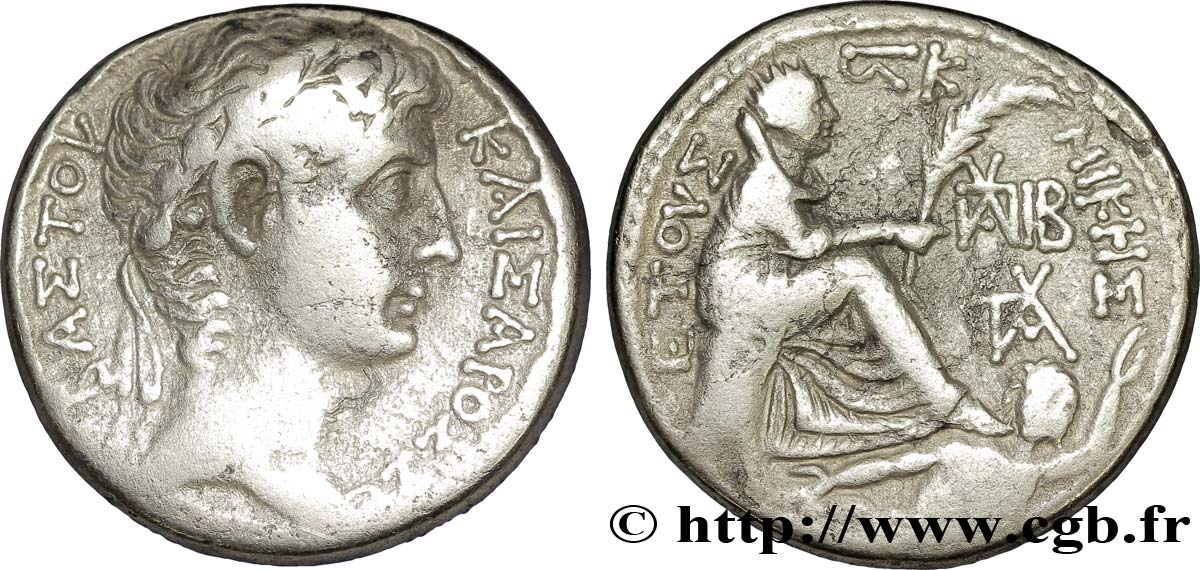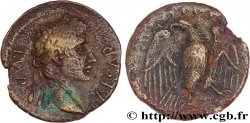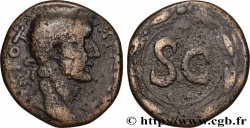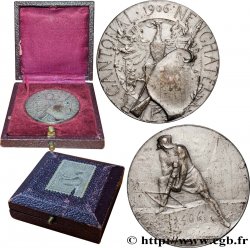bpv_295731 - AUGUSTUS Tétradrachme syro-phénicien
недоступный.
Товар уже продан в нашем интернет-магазине (2014)
Цена: : 350.00 €
Товар уже продан в нашем интернет-магазине (2014)
Цена: : 350.00 €
Тип Tétradrachme syro-phénicien
Дата: An 27 et 12e consulat
Монетный двор / Город: Antioche, Syrie, Séleucie et Piérie
Металл: silver
Диаметр: 26 mm
Ориентация осей монеты: 12 h.
Вес: 14,00 g.
Ссылки в каталоге: :
Происхождение:
Cet exemplaire est le 0050_044 de la base TSP
Лицевая сторона
Аверс: описание: Tête laurée d’Auguste à droite entouré de la stemma (O*).
Аверс: легенда: KAISAROS SEBASTOU (Kaisaros Sebastou)
Аверс: перевод: (César Auguste).
Обратная сторона
Реверс: Описание: Tyché (Ville d’Antioche) tourelée, voilée et drapée assise à droite sur un rocher, tenant une palme de la main droite ; à ses pieds à droite, l’Oronte nageant à droite.
Реверс: легенда: ETOUS - sK - NIKHS/ (UPAT) IB (Etous Nikhs)
Реверс: перевод: Nouvelle année victorieuse 26 / Douzième consulat / monogramme d’Antioche.
Комментарий
Ce type, qui s’étend de l’an 27 (5 AC) à la mort de l’Empereur, en l’an 44 du règne (14 AD) présente un type religieux plus œcuménique que ceux qu’utilisèrent les Séleucides : la Tyché de la ville d’Antioche.
On peut penser que l’Antioche de l’époque, probablement une ville de 150 à 200.000 habitants, était un creuset de cultes différents et que les Romains, plutôt que d’imposer un dieu particulier, choisirent une image dans laquelle tous les Antiochéens, voire tous les habitants de la région, pouvaient se reconnaître. La statue de la Tyché représentée au revers, était la statue cultuelle de l’artiste Eutychides, si célèbre que des copies d’époque nous en sont parvenues.
Dans la base TSP maintenue par Michel Prieur, quatre-vingt quinze exemplaires sont maintenant répertoriés dont dix en musées et collections publiques (Berlin, deux exemplaires, British Museum, Oxford, Yale, Paris, Vienne, Copenhague, Gotha et Glasgow).
This type, which extends from the year 27 (5 BC) to the death of the Emperor, in the year 44 of the reign (14 AD) presents a more ecumenical religious type than those used by the Seleucids: the Tyche of the city of Antioch. We can think that Antioch of the time, probably a city of 150 to 200,000 inhabitants, was a melting pot of different cults and that the Romans, rather than imposing a particular god, chose an image in which all the Antiochians, or even all the inhabitants of the region, could recognize themselves. The statue of the Tyche represented on the reverse, was the cult statue of the artist Eutychides, so famous that examples of it from the period have come down to us. In the TSP database maintained by Michel Prieur, ninety-five examples are now listed, including ten in museums and public collections (Berlin, two examples, British Museum, Oxford, Yale, Paris, Vienna, Copenhagen, Gotha and Glasgow)
On peut penser que l’Antioche de l’époque, probablement une ville de 150 à 200.000 habitants, était un creuset de cultes différents et que les Romains, plutôt que d’imposer un dieu particulier, choisirent une image dans laquelle tous les Antiochéens, voire tous les habitants de la région, pouvaient se reconnaître. La statue de la Tyché représentée au revers, était la statue cultuelle de l’artiste Eutychides, si célèbre que des copies d’époque nous en sont parvenues.
Dans la base TSP maintenue par Michel Prieur, quatre-vingt quinze exemplaires sont maintenant répertoriés dont dix en musées et collections publiques (Berlin, deux exemplaires, British Museum, Oxford, Yale, Paris, Vienne, Copenhague, Gotha et Glasgow).
This type, which extends from the year 27 (5 BC) to the death of the Emperor, in the year 44 of the reign (14 AD) presents a more ecumenical religious type than those used by the Seleucids: the Tyche of the city of Antioch. We can think that Antioch of the time, probably a city of 150 to 200,000 inhabitants, was a melting pot of different cults and that the Romans, rather than imposing a particular god, chose an image in which all the Antiochians, or even all the inhabitants of the region, could recognize themselves. The statue of the Tyche represented on the reverse, was the cult statue of the artist Eutychides, so famous that examples of it from the period have come down to us. In the TSP database maintained by Michel Prieur, ninety-five examples are now listed, including ten in museums and public collections (Berlin, two examples, British Museum, Oxford, Yale, Paris, Vienna, Copenhagen, Gotha and Glasgow)








 Cообщить об ошибке
Cообщить об ошибке Распечатать страницу
Распечатать страницу Отправить мой выбор
Отправить мой выбор Задать вопрос
Задать вопрос Consign / sell
Consign / sell
 Информация
Информация










